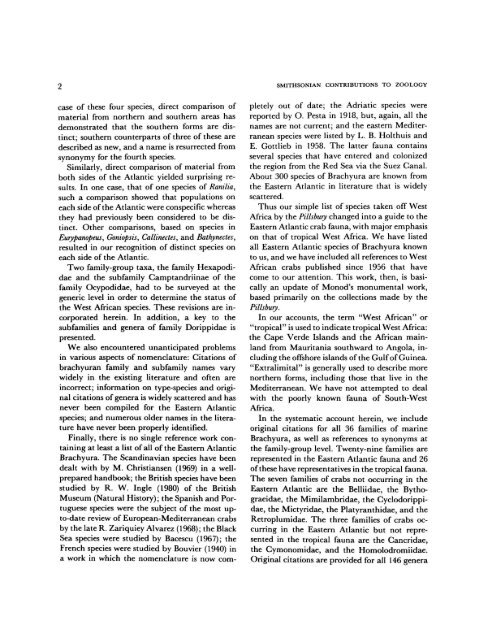West African Brachyuran Crabs - Smithsonian Institution Libraries
West African Brachyuran Crabs - Smithsonian Institution Libraries
West African Brachyuran Crabs - Smithsonian Institution Libraries
Create successful ePaper yourself
Turn your PDF publications into a flip-book with our unique Google optimized e-Paper software.
case of these four species, direct comparison of<br />
material from northern and southern areas has<br />
demonstrated that the southern forms are distinct;<br />
southern counterparts of three of these are<br />
described as new, and a name is resurrected from<br />
synonymy for the fourth species.<br />
Similarly, direct comparison of material from<br />
both sides of the Atlantic yielded surprising results.<br />
In one case, that of one species of Ranilia,<br />
such a comparison showed that populations on<br />
each side of the Atlantic were conspecific whereas<br />
they had previously been considered to be distinct.<br />
Other comparisons, based on species in<br />
Eurypanopeus, Goniopsis, Callinectes, and Bathynectes,<br />
resulted in our recognition of distinct species on<br />
each side of the Atlantic.<br />
Two family-group taxa, the family Hexapodidae<br />
and the subfamily Camptandriinae of the<br />
family Ocypodidae, had to be surveyed at the<br />
generic level in order to determine the status of<br />
the <strong>West</strong> <strong>African</strong> species. These revisions are incorporated<br />
herein. In addition, a key to the<br />
subfamilies and genera of family Dorippidae is<br />
presented.<br />
We also encountered unanticipated problems<br />
in various aspects of nomenclature: Citations of<br />
brachyuran family and subfamily names vary<br />
widely in the existing literature and often are<br />
incorrect; information on type-species and original<br />
citations of genera is widely scattered and has<br />
never been compiled for the Eastern Atlantic<br />
species; and numerous older names in the literature<br />
have never been properly identified.<br />
Finally, there is no single reference work containing<br />
at least a list of all of the Eastern Atlantic<br />
Brachyura. The Scandinavian species have been<br />
dealt with by M. Christiansen (1969) in a wellprepared<br />
handbook; the British species have been<br />
studied by R. W. Ingle (1980) of the British<br />
Museum (Natural History); the Spanish and Portuguese<br />
species were the subject of the most upto-date<br />
review of European-Mediterranean crabs<br />
by the late R. Zariquiey Alvarez (1968); the Black<br />
Sea species were studied by Bacescu (1967); the<br />
French species were studied by Bouvier (1940) in<br />
a work in which the nomenclature is now com-<br />
SMITHSONIAN CONTRIBUTIONS TO ZOOLOGY<br />
pletely out of date; the Adriatic species were<br />
reported by O. Pesta in 1918, but, again, all the<br />
names are not current; and the eastern Mediterranean<br />
species were listed by L. B. Holthuis and<br />
E. Gottlieb in 1958. The latter fauna contains<br />
several species that have entered and colonized<br />
the region from the Red Sea via the Suez Canal.<br />
About 300 species of Brachyura are known from<br />
the Eastern Atlantic in literature that is widely<br />
scattered.<br />
Thus our simple list of species taken off <strong>West</strong><br />
Africa by the Pillsbury changed into a guide to the<br />
Eastern Atlantic crab fauna, with major emphasis<br />
on that of tropical <strong>West</strong> Africa. We have listed<br />
all Eastern Atlantic species of Brachyura known<br />
to us, and we have included all references to <strong>West</strong><br />
<strong>African</strong> crabs published since 1956 that have<br />
come to our attention. This work, then, is basically<br />
an update of Monod's monumental work,<br />
based primarily on the collections made by the<br />
Pillsbury.<br />
In our accounts, the term "<strong>West</strong> <strong>African</strong>" or<br />
"tropical" is used to indicate tropical <strong>West</strong> Africa:<br />
the Cape Verde Islands and the <strong>African</strong> mainland<br />
from Mauritania southward to Angola, including<br />
the offshore islands of the Gulf of Guinea.<br />
"Extralimital" is generally used to describe more<br />
northern forms, including those that live in the<br />
Mediterranean. We have not attempted to deal<br />
with the poorly known fauna of South-<strong>West</strong><br />
Africa.<br />
In the systematic account herein, we include<br />
original citations for all 36 families of marine<br />
Brachyura, as well as references to synonyms at<br />
the family-group level. Twenty-nine families are<br />
represented in the Eastern Atlantic fauna and 26<br />
of these have representatives in the tropical fauna.<br />
The seven families of crabs not occurring in the<br />
Eastern Atlantic are the Belliidae, the Bythograeidae,<br />
the Mimilambridae, the Cyclodorippidae,<br />
the Mictyridae, the Platyranthidae, and the<br />
Retroplumidae. The three families of crabs occurring<br />
in the Eastern Atlantic but not represented<br />
in the tropical fauna are the Cancridae,<br />
the Cymonomidae, and the Homolodromiidae.<br />
Original citations are provided for all 146 genera

















